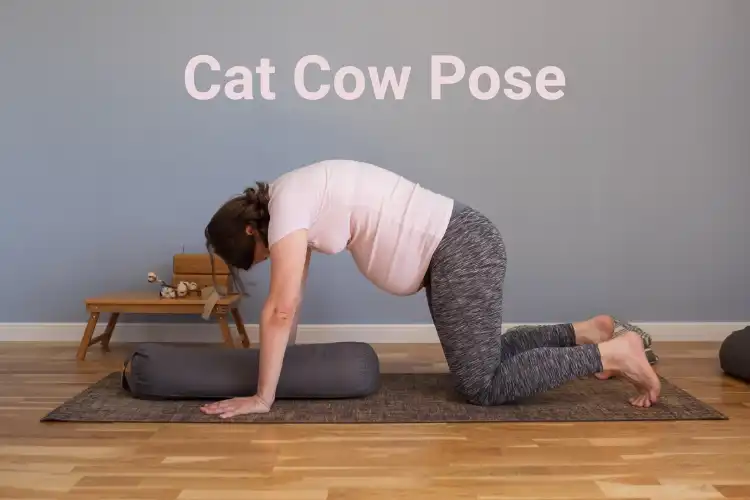Bitilasana - Tips for Better Performance of Cow Pose

Table of Content
Definition
Bitilasana is a yoga posture for beginners. It’s a soft position that almost everyone can do, regardless of skill level. Bitila means cow in Sanskrit, and asana means position. This position is usually done in tandem with the cat pose (marjaryasana).
Cat-Cow Pose:
Cat-Cow yoga pose is a gentle stream between two yoga poses (cat and cow) that warm you and make your body feel more flexible. It allows the back of your torso and neck to stretch and also stirs and reinforces your belly. It also helps to breathe deep, so that your chest is open.
- Cat Pose- Marjariasana — the name of this posture comes from the sanskrit words marjari, meaning cat and asana, meaning pose.
- Cow Pose– the name of this posture is derived from the sanskrit bitila (Bit-ill-Ah-Sun-aa), which means cow and asana, meaning pose.
Cat-Cow Stretch:
Cat-Cow pose is an excellent exercise of yoga especially when your body is looking for a fast break. Cat cow pose is also referred to as the chakravakasana and perfect for those who have regular pain in their back as it improves both balance and posture.
A yoga that’s essential and reasonable is the Cat-Cow stretch (chakravakasana). This includes transferring the spine from a circular position (bending) to an arched position (extension). Each step is taken along with an inhalation or breathing exhalation, making it an easy vinyasa (linking breath to movement).
Step-by-Step Instructions
Starting Position:
- Begin with your hands and knees, lined up your wrists below your hips, and your knees.
- Consider the spinal cord as a straight line between the shoulders and the hips. Try to visualise the line that stretches across the head and back of the tailbone. This is the neutral spine’s position.
- Hold the neck down and out for a while.
Inhale and Arch for Cow Pose
- Curl down your toes.
- Turn your pelvis back to the tailbone.
- Let your tailbone rip up your back to make your neck the last thing to move.
- Your belly falls, but keep your muscles abdominal embracing the spinal cord by drawing your belly button.
- Gently look up to the top without twisting your neck.
Exhale and Round for Cat Pose
- Put the tops of your feet off to the ground.
- Advance your pelvis, tuck your tailbone. Let your spine move this motion again. Naturally your backbone will be round.
- Pull your navel in toward your spine.
- Drop down your chin.
- Glance at your navel
- Replay and exhale the Cat-Cow stretch, which matches your own breath..
- Follow for 5 to 10 breaths. Return to a neutral spine after your final exhalation.
Modifications & Variations
Cat-Cow is an excellent beginner pose because it does not cause any pain. If you have to modify the position, try these simple modifications so that you can find the variation that is best suited for you:
- Put your forearms on the ground if your wrists suffer.
- To make your torso more upright, place your forearms on a bolster or a stack of firm blankets. This pose is particularly helpful for pregnant women.
- Fold your mat or put a sturdy blanket below your knees if your kneecaps are bothering you.
- This pose can be practised during travel. Place your feet flat on the floor in a chair (or airplane/bus seat). Apply the same spinal motions as in the normal pose by pressing your hands against a table, desk, or wall in front of you.
Don’t Strain Your Neck
Do this with control and don’t overstretch your neck when you lift your gaze to the ceiling. Let your head naturally fall when you go into Cat instead of forcing it down. Make sure your shoulders are comfortable and not pulled to your ears.
Keep the Movement in the Spine
Bring your hands straight so that the movement comes from your spine rather than your arms and elbows.
Benefits of Cat-Cow Asana
- A great opening of the spine: Since Cat-Cow pose is a position of the beginner, the position must be practised since it opens the whole of the spinal cord. The smooth movement of the spine removes blockages and facilitates prana flow. The fast prana flow helps keep the spinal cord.
- Strengthens the arms and the shoulders: When practiced consistently for more than 2 to 3 minutes, the Cat-Cow pose helps open the tight muscles and improves strength slowly.
- Deep stretch to the neck improves flexibility: In Cat pose the movements of the neck tighten the front of the head and extend the muscle of the back of the neck, while the movements of the nose tightens the back of the neck and spans the front neck muscles.This repetitive movement tends to make the neck flexible with repeated practise over a period of time.
- Massages the internal organs thus improving digestion.
- Good for women during difficult times of menstruation.
- A good pose for pregnant women: This posture is mainly taken into consideration or used in prenatal yoga lessons, because it is good for both mother and the foetus.
- Helps in the treatment of insomnia as a restorative pose..
- Activates the adrenal glands.
- Activates the pancreas.
- Helps to keep the reproductive organs healthy.
Safety and Precautions
- If you have a neck injury, keep your head in line with your torso and don’t drop it forward or back.
- Cow posing and bringing the back to neutral position should only be used by pregnants and those with back injuries — do not allow the bowels to drop between repetitions, since it can strain the lower back.
- This asana should be painless. Gently return back if you feel any pain.
- If you have back pain that exists before you do this exercise, consult with your yogic guide to make sure it’s right for your situation.
Tips
Cat-cow practise can warm up and prepare the body for numerous activities. Please take into consideration the following information in practise:
- Let your head fall in Cat pose and let your neck free. Keep your chin from collapsing into your chest.
- In Cat pose, you can also do the abdominal massage and enhance the results by tightening your belly button in the back.
- Let the motion start from the tailbone in Cow pose. Ensure the last part of the movement to be your neck and head.
- Keep the blades broad and pull the shoulders off your ears. This helps secure your neck when moving.
- Be mindful that your breath and your movement are in line. Imagine your breath as you inhale and exhale, like a sea wave that flows to the beach and withdraws.
You may also like to read:-
Ashtanga Yoga Postures & Sequences You Should Know About.
How to Practice for Nadi Shodhan Pranayama?
Aerial Yoga – The New Exciting Fitness Methodology.
















